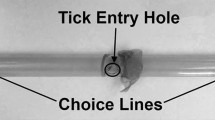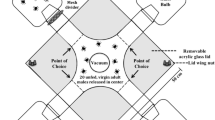Abstract
Ticks and mites respond to a limited spectrum of stimuli in their search for hosts and mates. Airborne chemical signals include carbon dioxide, ammonia, organic acids, terpenoids, 2,6-dichlorophenol, and other phenolic compounds. These are detected primarily by sensilla in and adjacent to Haller's organ. Most ixodid species examined have one or more multiporose sensilla that detect such volatiles. These olfactoreceptors enable the ticks to respond to remote volatile chemicals from hosts and from the other ticks, e.g., sex pheromones. Other sensilla, probably mechanogustatory in function, also occur on the tarsi. Gustatory sensilla on the palps detect assembly pheromones that enable ticks and mites to respond to conspecific or heterospecific chemical stimuli in their environment. Responses to those stimuli in ticks result in clustering, i.e., arrestant behavior. Arrestant behavior also occurs in certain mites. Finally, cheliceral chemosensilla enable ticks to recognize specific phagostimulants in host blood, e.g., ATP and glutathione, that stimulate feeding. InDennacentor variabilis andD. andersoni, these same cheliceral chemosensilla recognize species-specific genital sex pheromones in the vulvae of conspecific mates, without which they do not copulate.
Similar content being viewed by others
References
Balashava, Yu.S., Ivanov, V.P., andIgnatev, A.M. 1976. Fine structure of the palpal receptor organ in ixodid ticks (Acerina: Ixodoidea).Zool. Zh. 55:1308–17.
Blum, M. 1981. Chemical Defenses of Arthropods. Academic Press, New York. 562 pp.
Davis, J.C., andCamin, J.H. 1976. Setae of the anterior tarsi of the martin mite,Dermanyssus prognephilus (Acari: Dermanyssidae).J. Kans. Entomol. Soc. 49:441–449.
Feldman-Muhsam, B., andBorut, S. 1971. Copulation in ixodid ticks.J. Parasitol. 57:630–634.
Foelix, R.F., andAxtell, R.C. 1971. Fine structure of tarsal sensilla on the tick,Amblyomma americanum (L.)Z. Zellforsch Mikrosk. Anat. 114:22–37.
Foelix, R.F., andAxtel, R.C. 1972. Ultrastructure of Haller's organ in the tick,Amblyomma americanum (L.)Z. Zellforsch Mikrosk. Anat. 124:275–292.
Foelix, R.F. andI.W. Chu-Wang. 1972. Fine structural analysis of palpal receptors in the tick,Amblyomma americanum (L.). Z. Zellforsch. 129:548–560.
Gothe, R. andKraiss, A. 1982. Zur Lokalisation der Pheromonemission und Perseption beiArgas (Persicargas) walkerae) Kaiser and Hoogstraal, 1969.Zentralbl. Veterinaermed. Reihe B 29:573–582.
Graf, J.F. 1975. Ecologie et éthologied'Ixodes ricinus L. en Suisse.Acarologia 17:436–441.
Haggart, D.A., andDavis, E.E. 1979. Electrophysiological responses of two types of ammonia- sensitive receptors on the first tarsi of ticks.Recent Adv. Acarol. 1:421–425.
Haggart, D.A., andDavis, E.E. 1980. Ammonia-sensitive neurons on the first tarsi of the tick.Rhipicephalus sanguineus.J. Insect Physiol. 26:517–523.
Haggart, D.A., andDavis, E.E. 1981 Neurone sensitive to 2,6-dichlorophenol on the tarsi of thetick Amblyomma americanum (Acari: Ixodidae).J. Med. Entomol. 18:187–193.
Hess, E., andVlimant, M. 1980. Morphology and fine structure of tarsal chemosensory hairs of the tickAmblyomma variegatum (Acarina, Ixodidae, Metastriata) including preliminary electrophysiological results.Proc. Olfaction Taste 7:190.
Hess, E., andVlimant, M. 1982a. The tarsal sensory system ofAmblyomma variegatum Fabricius (Ixodidae, Metastriata) I. Wall pore and terminal pore sensilla.Rev. Suisse Zool. 89:713–729.
Hess, E., andVlimant, M. 1982b. The tarsal sensory system ofAmblyomma variegatum Fabricius (Ixodidae, Metastriata) II. No pore sensilla.Rev. Suisse Zool. 90:157–167.
Ivanov, V.P., andLeonovich, S.A. 1983. Sensory organs, pp. 190–220,in Yu. S. Balashov (ed.). An Atlas of Ixodid Tick Ultrastructure. Nauka, Leningrad, 1979. English translation edited by A.S. Raikhel and H. Hoogstraal. Special publication, Entomological Society of America, 289 pp. with 415 figures.
Khaul, G.M., Sonenshine, D.E., Sallam, O.A., andHomsher, P.J. 1983. Mating regulation and reproductive isolation in the ticksHyalomma dromedarii andH. anatolicum excavatum (Acari: Ixodoidea: Ixodidae);J. Med. Entomol 20:136–145.
Leonovich, S.A. 1977. Electron microscopy studies of Haller's organ of the tickIxodes persulcatus Ixodidae.Parazitologiya 11:340–346.
Moritsch, Ch., Sixl-Voigt, B., Sixl, W., andFain, A. 1979. Das Sinnesfeld am Tarsus I bei nasalen Milben am Beispiel vonMesonyssus melieri. In E. Piff (ed) Proceedings, 4th International Congress of Acarology. pp. 717–723. Akademiai Kiado, Budapest.
Regev, S., andCone, W.W. 1980. The monoterpene citronellol as a male sex attractant of the twospotted spider mite,Tetranychus urticae (Acarina: Tetranychidae).Environ. Entomol. 4:307–311.
Schoni, R., Hess, E., Blum, W., andRamstein, K. 1984. The aggregation-attachment pheromone of the tropical bont tick.Amblyomma variegatum Fabricius (Acari: Ixodidae). Isolation, identification and action of its active componentsJ. Insect Physiol. 30:613–618.
Silverstein, R.M., West, J.R., Sonenshine, D.E., andKhalil, G.M. 1983. Occurrence of 2,6- dichlorophenol in the hard ticks,Hyalomma dromedarii andHyalomma anatolicum excavatum and its role in mating.J. Chem. Ecol. 9:1543–1549.
Solomon, K.R., Mango, C.K.A., andObenchain, F.D. 1982. Endocrine mechanisms in ticks. Effects of insect hormones and their mimics on development and reproduction, pp. 399–438,in F.D. Obenchain and R. Galum (eds.). Physiology of Ticks. Pergamon Press, Oxford.
Sonenshine, D.E., Silverstein, R.M., andRechav, Y. 1982a. Tick pheromone mechanisms, pp. 439–468,in F.D. Obenchain and R. Galum (eds.). Physiology of Ticks. Pergamon Press, Oxford.
Sonenshine, D.E., Khalil, G.M., Homsher, P.J., andMason, S.N. 1982b.Dermacentor variabilis andDermacentor andersoni: Genital sex pheromones.Exp. Parasitol. 54:371–30.
Sonenshine, D.E., Homsher, P.J., Carson, K.A., andWang, V.B. 1984. Evidence of the role of the cheliceral digits in the perception of genital sex pheromones during mating in the American dog tick,Dermacentor variabilis (Say) (Acari: Ixodidae).J. Med. Entomol. 21:296–306.
Sonenshine, D.E., Silverstein, R.M., Brossut, R., Davis, E.E., Taylor, D., Carson, K.A., andWang, V.B. 1986. The genital sex pheromones of ixodid ticks. 1. Evidence of occurrence in the anterior reproductive tract of the American dog tick,Dermacentor variabilis (Say).J. Chem. Ecol. 12:1669–93.
Sonenshine, D.E. 1985. Pheromones and other semichemicals of the Acari.Annu. Rev. Entomol. 30:1–28.
Staddon, B.W. 1979. The scent glands of Heteroptera.Adv. Insect Physiol 14:351–418.
Waladde, S.M. 1982. Tip-recording from ixodid tick olfactory sensilla: Responses to tick related odours.J. Comp. Physiol. A 148:411–418.
Waladde, S.M., andRice, M.J.1977. The sensory nervous system of the adult cattle tick,Boophilus microplus (Canestrini). Ixodidae. Part III. Utrastructure and electrophysiology of cheliceral receptors.J. Aust. Entomol. Soc. 16:441–543.
Waladde, S.M., andRice, M.J.1982. The sensory basis of tick feeding behavior, pp. 71–118,in F.D. Obenchain and R. Galun (eds.). Physiology of Ticks, Vol. 1. Pergamon Press. Oxford.
Wilson, J.G., Kinzer, D.R., Sauer, J.R., andHair, J.A. 1972. Chemoattraction in the lone star tick (Acarina: Ixodidae). 1. Responses of different developmental stages to carbon dioxide adminstered via traps.J. Med. Entomol. 9:254–252.
Wood, W.F., Leahy, M.G., Galun, R., Prestwich, G.D., Meinwald, J., Purnell, R.E., andPayne, R.C. 1975. Phenols as pheromones of ixodid ticks: A general phenomenon.J. Chem. Ecol. 1:501–509.
Author information
Authors and Affiliations
Rights and permissions
About this article
Cite this article
Sonenshine, D.E., Taylor, D. & Carson, K.A. Chemically mediated behavior in Acari: Adapations for finding hosts and mates. J Chem Ecol 12, 1091–1108 (1986). https://doi.org/10.1007/BF01638998
Received:
Accepted:
Issue Date:
DOI: https://doi.org/10.1007/BF01638998




